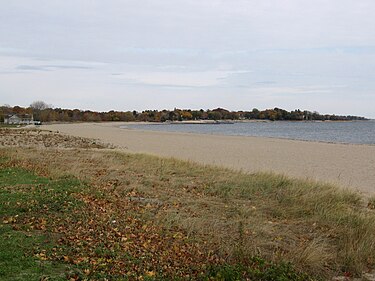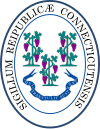The Connecticut Portal

Connecticut (/kəˈnɛtɪkət/ kə-NET-ik-ət) is the southernmost state in the New England region of the Northeastern United States. It borders Rhode Island to the east, Massachusetts to the north, New York to the west, and Long Island Sound to the south. Its capital is Hartford, and its most populous city is Bridgeport. Connecticut lies between the major hubs of New York City and Boston along the Northeast Corridor. The New York metropolitan area, which includes six of Connecticut's seven largest cities, extends well into the southwestern part of the state, while the northeastern corner reaches Greater Boston. Connecticut is the third-smallest state by area after Rhode Island and Delaware, and the 29th most populous with slightly more than 3.6 million residents as of 2020, ranking it fourth among the most densely populated U.S. states.
The state is named after the Connecticut River, the longest in New England which roughly bisects the state and drains into the Long Island Sound between the towns of Old Saybrook and Old Lyme. The name of the river is in turn derived from anglicized spellings of Quinnetuket, a Mohegan-Pequot word for "long tidal river". Before the arrival of the first European settlers, the region was inhabited by various Algonquian tribes. In 1633, the Dutch West India Company established a small, short-lived settlement called House of Hope in Hartford. Half of Connecticut was initially claimed by the Dutch colony New Netherland, which included much of the land between the Connecticut and Delaware Rivers, although the first major settlements were established by the English around the same time. Thomas Hooker led a band of followers from the Massachusetts Bay Colony to form the Connecticut Colony, while other settlers from Massachusetts founded the Saybrook Colony and the New Haven Colony; both merged into the former by 1664.
Connecticut's official nickname, the "Constitution State", refers to the Fundamental Orders adopted by the Connecticut Colony in 1639, which is considered by some to be the first written constitution in Western history. As one of the Thirteen Colonies that rejected British rule during the American Revolution, Connecticut was influential in the development of the federal government of the United States. In 1787, Roger Sherman and Oliver Ellsworth, state delegates to the Constitutional Convention, proposed a compromise between the Virginia and New Jersey Plans; its bicameral structure for Congress, with a respectively proportional and equal representation of the states in the House of Representatives and Senate, was adopted and remains to this day. In January 1788, Connecticut became the fifth state to ratify the Constitution. (Full article...)
Ethan Allen (January 21, 1738 [O.S. January 10, 1737] – February 12, 1789) was an American farmer, writer, military officer and politician. He is best known as one of the founders of Vermont and for the capture of Fort Ticonderoga during the American Revolutionary War, and was also the brother of Ira Allen and the father of Fanny Allen.
Allen was born in rural Connecticut and had a frontier upbringing, but he also received an education that included some philosophical teachings. In the late 1760s, he became interested in the New Hampshire Grants, buying land there and becoming embroiled in the legal disputes surrounding the territory. Legal setbacks led to the formation of the Green Mountain Boys, whom Allen led in a campaign of intimidation and property destruction to drive New York settlers from the Grants. He and the Patriot-aligned Green Mountain Boys seized the initiative early in the Revolutionary War and captured Fort Ticonderoga in May 1775. In September 1775, Allen led a failed attempt on Montreal which resulted in his capture by the British. He was imprisoned aboard ships of the Royal Navy, then paroled in New York City, and finally released in a prisoner exchange in 1778. (Full article...)
General images -
Selected picture -

State facts
- Nicknames: The Provisions State, The Land of Steady Habits, The Constitution State, The Nutmeg State
- Capital: Hartford
- Governor: Ned Lamont (D)
- Lieutenant Governor: Susan Bysiewicz (D)
- Secretary of State: Stephanie Thomas (D)
- Attorney General: William Tong (D)
- Senators: Chris Murphy (D), Richard Blumenthal (D)
- Representatives: Jahana Hayes (D), Jim Himes (D), Joe Courtney (D), John B. Larson (D), Rosa DeLauro (D)
- Total area: 5,543 mi2
- Land: 4,845 mi2
- Water: 698 mi2
- Highest elevation: 2,379 ft (Mount Frissell)
- Population 3,576,452 (2015 est)
- Admission to the Union: January 9, 1788 (5th)
State symbols:
- Animal: Sperm whale
- Bird: American Robin
- Fish: American Shad
- Flower: Mountain Laurel
- Fossil: Dinosaur Track
- Insect: European Praying Mantis
- Ship: USS Nautilus (SSN-571)
- Songs: Yankee Doodle
- Tree: Charter Oak
- Mineral: Almandine
Selected article -

The Connecticut Colony, originally known as the Connecticut River Colony, was an English colony in New England which later became the state of Connecticut. It was organized on March 3, 1636 as a settlement for a Puritan congregation of settlers from the Massachusetts Bay Colony led by Thomas Hooker. The English would secure their control of the region in the Pequot War. Over the course of the colony's history it would absorb the neighboring New Haven and Saybrook colonies. The colony's founding document, the Fundamental Orders of Connecticut has been called the first written constitution of a democratic government, earning Connecticut the nickname "The Constitution State." (Full article...)
Did you know? -
- ... that the Meriden, Waterbury and Connecticut River Railroad, created as an alternative to the New Haven Railroad, was absorbed into the New Haven after just 11 years?
- ... that Cora Slocomb di Brazza designed the peace flag adopted by the International Council of Women, and her mother Abby Day Slocomb designed the Connecticut state flag?
- ... that Darien, Connecticut, was once home to a train station built inside a cemetery?
- ... that in 2023, Ralph Nader founded the newspaper Winsted Citizen in his hometown of Winsted, Connecticut, where he delivered papers as a boy?
- ... that the directors of the Dutchess and Columbia Railroad stole back the railroad from a bankrupt lessee?
- ... that under a new Connecticut law, abortion providers in the state can countersue anyone who sues them under the Texas Heartbeat Act?
In the news

- February 10: Disney to shut down Blue Sky Studios, animation studio behind 'Ice Age'
- October 17: Hundreds arrested for 'dark web' child porn by international task force
- October 3: World War II era plane crashes in Connecticut, US, killing at least seven
- February 21: Sixteen states sue U.S. President Trump to stop declaration of emergency for border wall
Categories
Related WikiProjects

WikiProject Connecticut • WikiProject Connecticut routes • WikiProject UCONN
Selected panorama
Topics
Related portals
Associated Wikimedia
The following Wikimedia Foundation sister projects provide more on this subject:
-
Commons
Free media repository -
Wikibooks
Free textbooks and manuals -
Wikidata
Free knowledge base -
Wikinews
Free-content news -
Wikiquote
Collection of quotations -
Wikisource
Free-content library -
Wikiversity
Free learning tools -
Wikivoyage
Free travel guide -
Wiktionary
Dictionary and thesaurus
























































